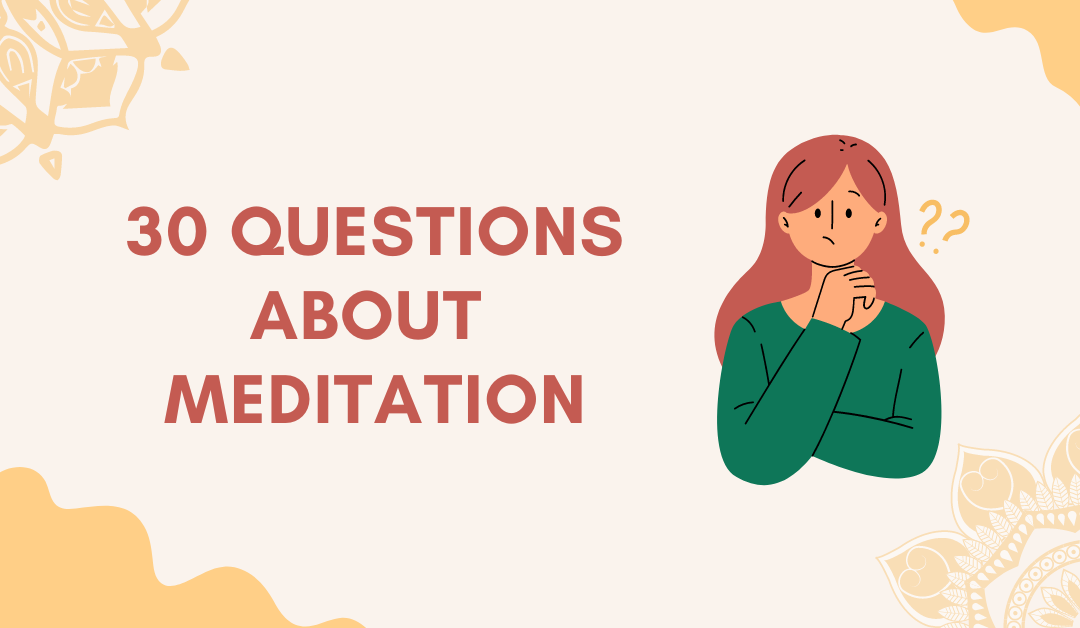Are you just getting started with meditation or exploring the practice? You likely have a ton of questions about the practice itself, what you need to get started or even its origins. Don’t worry – we have you covered. We’ve rounded up 30 of the most common questions about meditation to help you learn more about this practice.
What is Meditation?
Meditation is an ancient practice dating back thousands of years. The word “meditation” originates from the Latin word “meditatum,” which means “to ponder.”
The purpose of the practice is to focus or clear your mind, which can help:
- Reduce stress
- Allow you to relax
- Reduce anxiety
- Improve concentration
There are many types of meditation, each of which has its own methods or techniques for achieving a calm, relaxed mind. These techniques may include:
- Focusing on an object
- Repeating a mantra
- Focusing on the breath
- Walking or performing some other type of movement
Where Did Meditation Originate?
Because meditation is an ancient practice that’s been around for thousands of years, it can be tricky to pinpoint its exact origin.
The earliest documented records of meditation are from the Hindu traditions of India around 1500 BCE.
Other forms of meditation have also been documented in the 6th and 5th centuries BCE in Buddhist India and Taoist China.
We can also find written accounts of different meditative states in the Pāli Canon sutras that date all the way back to the 1st century BCE in Buddhist India.
There are many theories on the origins of meditation, but the truth is that we just don’t know.
However, there have been a few key people who have helped spread the meditation practice, including:
- The Buddha, also known as Siddhārtha Gautama or Siddhattha Gotama. His teachings are the foundation of Buddhism.
- Dosho, a Japanese monk from the 7th century who traveled to China and studied Buddhism. After learning the Zen process, he returned to Japan and shared it with others.
- Lao-Tze, an ancient philosopher from China and author of Tao-te-Ching. The text became the foundation of Taoism, which speaks of meditation and finding wisdom in silence.
Meditative practices have been a part of many cultures and religions around the world for centuries, even if these practices are not explicitly called “meditation.”
How Can Meditation Benefit Your Daily Life?
Many people find that meditation benefits their daily lives in several ways, including:
- Developing a sense of peace and balance in your life. One study of more than 150 adults found that using a meditation app for two weeks helped reduce feelings of loneliness compared to a control group.
- Improving anxiety. One meta-analysis that included more than 1,000 adults found that meditation may help reduce anxiety, especially for people with high levels of anxiety. Another study found that 8 weeks of mindfulness meditation helped reduce anxiety symptoms in people with generalized anxiety disorder.
- Reducing stress. One review found that meditation can indeed reduce stress. Another 8-week study found that mindfulness meditation helped reduce the stress-induced inflammation response.
- Helping improve emotional health. One review of 18 studies found that meditation helped reduce symptoms of depression compared to individuals in a control group. Another review found that meditation can reduce cytokine levels, inflammatory chemicals linked to depression.
- Increasing focus. One review found that meditation may reverse brain patterns that contribute to worrying and mind wandering. Even short periods of meditation can help with your focus. One study found that practicing for 13 minutes a day improved memory and attention after eight weeks.
Many people also find that meditation helps improve their pain, sleep and even their compassion.
People are affected by meditation in different ways, so the practice can provide a wide range of benefits that are unique to each individual.
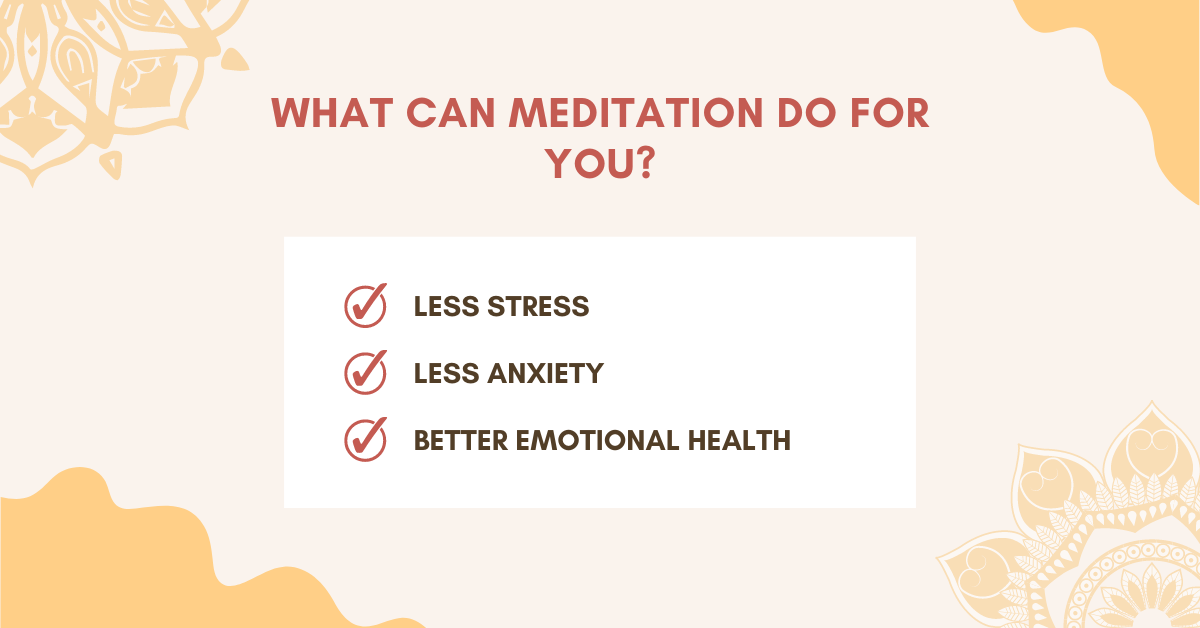
How Does Meditation Differ from Relaxation or Self-Hypnosis?
Meditation can help put you into a calm, relaxed state. You may have also seen people who get so deep into their meditation practice that it looks like they’re in a state of hypnosis. Is meditation really different from these two things?
Yes!
The goal of meditation is to enhance your perception of the present moment. The feeling of meditation is often compared to a heightened state of wakefulness. You become hyper-aware of your mind, body and surroundings.
On the other hand, self-hypnosis is often compared to the feeling of being in a dream-like state.
Meditation also differs from relaxation. While meditation can certainly help you relax, many people find that the practice helps them discover how their minds work. It becomes a journey of self-discovery rather than simply easing tension or stress.
When Should I Meditate?
The great thing about meditation is that there’s no right or wrong time to do it. It’s something that you can do anytime, anywhere.
That said, you may find that you have better meditation sessions at certain times of the day. Meditation is best performed at a time and place that is:
- Quiet
- Free of distractions
- Comfortable
Skilled meditators can meditate in any situation, even in crowded, busy streets. But most people will find that they can only really get into a deep meditative state if they are in a calm, quiet place.
Determine which time of day will work best for your sessions. Many people find that first thing in the morning works best because it helps them start the day on the right foot – and it’s usually quiet in the morning.
How Do I Get Started with Meditation?
Getting started is always the hardest part of any new activity or practice, and meditation is no exception.
Meditation doesn’t require any tools or equipment, but a little guidance can go a long way in making your sessions more fruitful and less frustrating.
Guidance can come from:
- A meditation teacher or course
- Guided meditations
- Books or audiobooks
An app like Headspace can help you ease into the practice and will provide helpful tips. You can also find many free guided meditations on YouTube that will introduce you to the practice and give you a chance to try it out with no monetary commitment.
Why Should I Meditate?
Everyone has their own reasons for practicing meditation. It’s important to find yours. If you don’t have a personal reason for meditating, you may find it difficult to stay motivated to continue your practice.
Many people start meditating because they want to:
- Ease their anxiety and reduce the stress in their lives.
- Improve their symptoms of depression.
- Discover more about their minds and themselves.
- Learn how to become more resilient to stress.
Others choose to start meditating because of the brain benefits it offers. Research has found that meditation can strengthen areas of the brain associated with learning, memory, self-awareness and attention.
How Can I Make Meditation a Habit?
The best way to make any new activity a habit is to do it consistently. Some experts say that it takes 30 days to form a habit, but it may take you more or less time to reach this point.
How can you ensure you practice meditation regularly?
- Make it a priority.
- Do it in the morning or just before bed.
- Create a meditation space that you look forward to being in.
- Commit to doing just a few minutes a day, and gradually increase the time.
Have patience and be kind to yourself. If you fall out of the habit, don’t beat yourself up. The most important thing is to keep trying your best to meditate regularly.
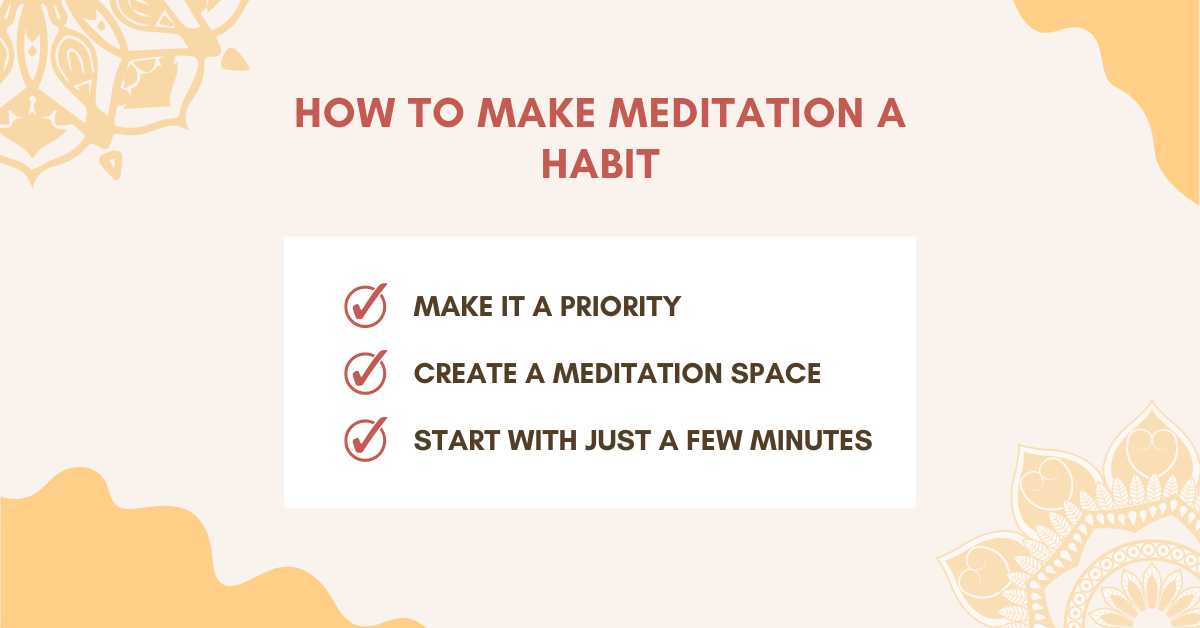
What is the Difference Between Meditation and Mindfulness?
The terms mindfulness and meditation are often used interchangeably. After all, mindfulness meditation is a popular practice.
However, while similar in nature, these two terms technically have different meanings.
- Mindfulness is the act of paying attention to and being aware of your surroundings or whatever activity you’re engaging in. When someone is being mindful, they are aware of their thoughts, behaviors, feelings, movements and even their effects on others.
- Meditation is an intentional practice where you bring all of your awareness to your breath or another single point of focus.
During meditation, you may become more mindful of your surroundings, and this is what is known as mindfulness meditation.
While these two practices are connected, they are still separate things. You can meditate without practicing mindfulness and vice versa.
Should Your Eyes Be Opened or Closed During Meditation?
Many new meditators wonder whether they should keep their eyes open or closed when meditating. The truth is that there’s really no right or wrong answer here.
Some people prefer to keep their eyes closed, while others find it easier to stay fixated on an object if their eyes are open.
Try experimenting with your eyes opened and with your eyes closed to see which one you prefer.
How Long Should I Meditate For?
There’s no minimum or maximum time you should meditate for – it’s all about your own personal limit.
Many beginners find that 5-10 minutes a day works for them to get started with the practice. It’s not uncommon for more experienced people to meditate for an hour or more at a time.
Here are a few things to know:
- If your goal is to reduce stress, 10 minutes is all you need.
- If your goal is to improve concentration and anxiety, 30+ minutes is ideal.
Mindfulness-Based Stress Reduction therapy recommends practicing for 40-45 minutes each day. In some Buddhist traditions, it’s common to meditate for just 15 minutes at a time.
How Can I Ignore Distractions During Meditation?
One of the biggest challenges of meditation is learning how to ignore or overcome distractions. Imagine that you’re trying to meditate but your roommate is blasting their music, the neighborhood kids are yelling outside, and your phone won’t stop buzzing.
Today, we have more distractions than ever, and that can make it hard to get into the right state of mind for meditation.
How can you ignore distractions? Here are some tips:
- Set yourself up for success. Give yourself time for your practice. Choose a quiet spot with minimal distractions. Put your phone on silent, and wear headphones. Let your friends and family know that you’re dedicating this time to meditation and that you do not want to be disturbed.
- Redirect your focus when you get distracted. If you find yourself getting distracted by sounds or thoughts, redirect your attention to your breath or whatever object you’re focusing on. Do not beat yourself up about it—practice non-resistance. Be present with the distraction and redirect your attention back to where you want it to be.
Treat each experience as a lesson. Reflect on how your mind works and what kinds of distractions have the strongest pull for you. By better understanding what distracts you, you can take steps to reduce distractions or learn how to identify them and redirect your attention.
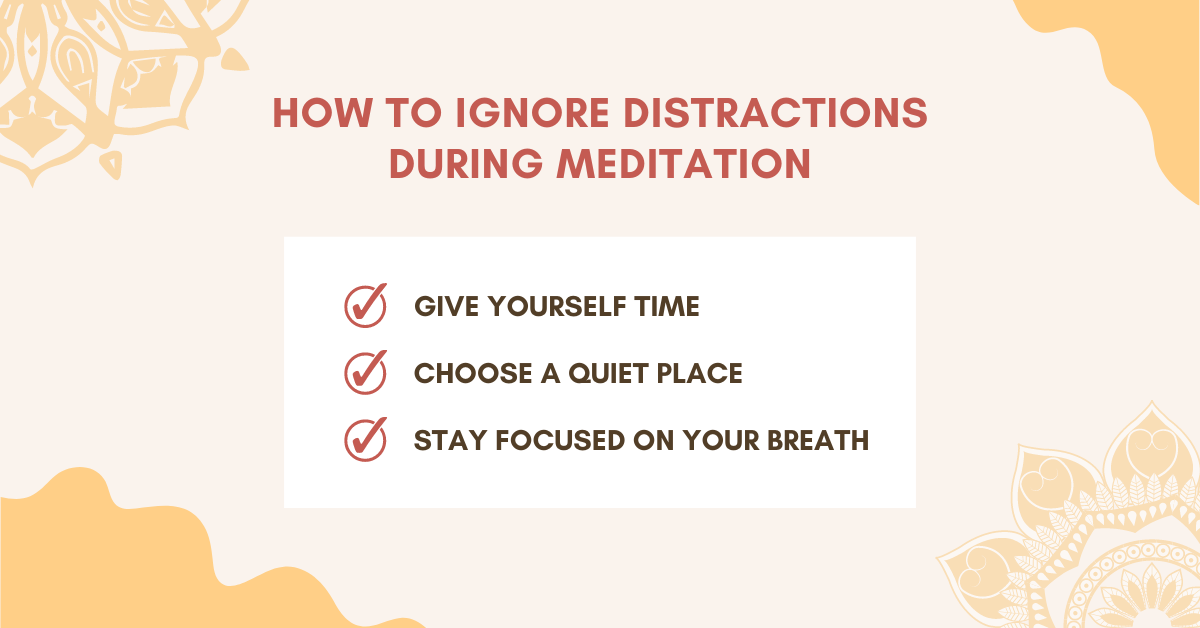
Does Meditation Have to be a Religious or Spiritual Practice?
Although meditation has religious and spiritual roots, it does not necessarily have to be practiced for these purposes.
Many people use mindfulness-based meditation to simply:
- Reduce stress and anxiety
- Bring a sense of balance and peace to their lives
- Learn how to improve their focus and memory
Whether or not you explore the spiritual or religious aspects of this practice is entirely up to you. At the end of the day, meditation is simply sitting peacefully.
Should I Meditate If I Already Do Things Like Yoga or Exercise?
Meditation is a mental practice, not a physical one. So, it’s perfectly fine to meditate if you already engage in physical activities, even those that may feel meditative, like running or yoga.
In fact, many people find that meditation helps enhance their exercise routines and gives them the extra energy boost they need to get moving.
Is There a Right or Wrong Way to Meditate?
The great thing about meditation is that there’s no right or wrong way to do it. However, it’s important to find a method or practice that works well for you and your needs.
You may find that some methods or types of meditation don’t work well for you. In this way, you could argue that there’s a “wrong” way to meditate simply because the practice isn’t meeting your needs.
But as a general rule of thumb, you can’t really meditate the wrong way or even be bad at meditation. Remember – it’s all about accepting the present moment as it is and without judgment.
What is a Meditation Object?
Meditation objects are used in object meditation, which is a visual-based practice where you focus on one particular thing.
A meditation object can be just about anything:
- A tree outside
- A candle
- A visual picture in your mind
It doesn’t matter what the object is as long as you can maintain your focus on it without judgment or labels.
Why is Breath Awareness So Important in Meditation?
Breath awareness is a traditional focus for meditation practices, but why? Because it’s something that is ever-present and relatively simple to focus on.
Additionally, paying attention to the rise and fall of your breath can help you naturally take longer and deeper inhales and exhales, helping you relax and easing stress.
Breath awareness also helps synchronize the mind and body so that you become fully aware and immersed in the present moment.
Where Should I Meditate?
Just as there is no right or wrong way to meditate, there is no right or wrong place to practice. Skilled meditators can practice anywhere, including the busiest and noisiest of streets in a city.
That said, most people find that the best place to meditate is one that is:
- Quiet
- Safe
- Peaceful
- Free from distractions
This place can be anywhere, from your front porch to your local park.
Do I Have to Sit Cross-legged When I Meditate?
No, you don’t have to sit in a cross-legged position when meditating. You can sit in whatever position you like. The most important thing is to be comfortable.
Many people find that sitting in a cross-legged position puts too much stress on their knees. The last thing you want is to be in pain or uncomfortable when you’re trying to relax and get into a meditative state. So, find a position that works for you. You can also use a meditation cushion or stool, which will take some of the stress off of your knees.
Should I Listen to Music While Meditating?
It’s perfectly fine to listen to music while meditating. In fact, many people find that music helps them get into a deeper meditative state. Just make sure that you choose relaxing music that won’t be too distracting.
Remember that there’s no right or wrong way to meditate. If music helps you with your practice and you enjoy listening to it while you meditate, then continue to do so.
What Do I Need to Get Started with Meditation?
The beauty of meditation is that you only need two things to get started: a peaceful place and time. You can spend money on fancy cushions and courses if you want, but ultimately, all you need is time and a place to practice.
Do I Have to Have a Blank Mind to Meditate?
Many people are intimidated by meditation because they’ve been told they have to empty their minds or keep their minds blank while practicing. But if you’re a beginner, it can be extremely difficult to keep your mind free of noise and chatter at first.
Rather than telling yourself not to think while meditating, just allow things to be as they are in the moment without attachment or judgment. Witness and observe your thoughts, and then let them go. Don’t get caught up in them.
How Do I Stop Feeling Restless or Uncomfortable While Meditating?
If you’re feeling restless, acknowledge it. Observe your restlessness, allow it to be and explore the feeling. Why are you feeling restless? Remember to be kind to yourself. It’s okay to feel this way. You may find that shorter meditation sessions can help you avoid that feeling of restlessness in the beginning. As you get used to the practice, you can extend your time.
If you’re feeling uncomfortable, try moving around and finding a position where you feel relaxed but still awake and alert.
It’s normal to feel restless or uncomfortable when you first start meditating. Even if you’ve been practicing for years, you may still encounter these experiences.
What Should I Do if I Keep Falling Asleep While Meditating?
Many beginners fall asleep during their meditation sessions. It’s normal and common, so don’t stress about it. But if you find that you’re always falling asleep and having trouble progressing with your meditation, here are some tips:
- Try not to meditate after eating
- Practice away from the bedroom
- Take your meditation outdoors
- Try walking meditation
- Keep your eyes open while you meditate
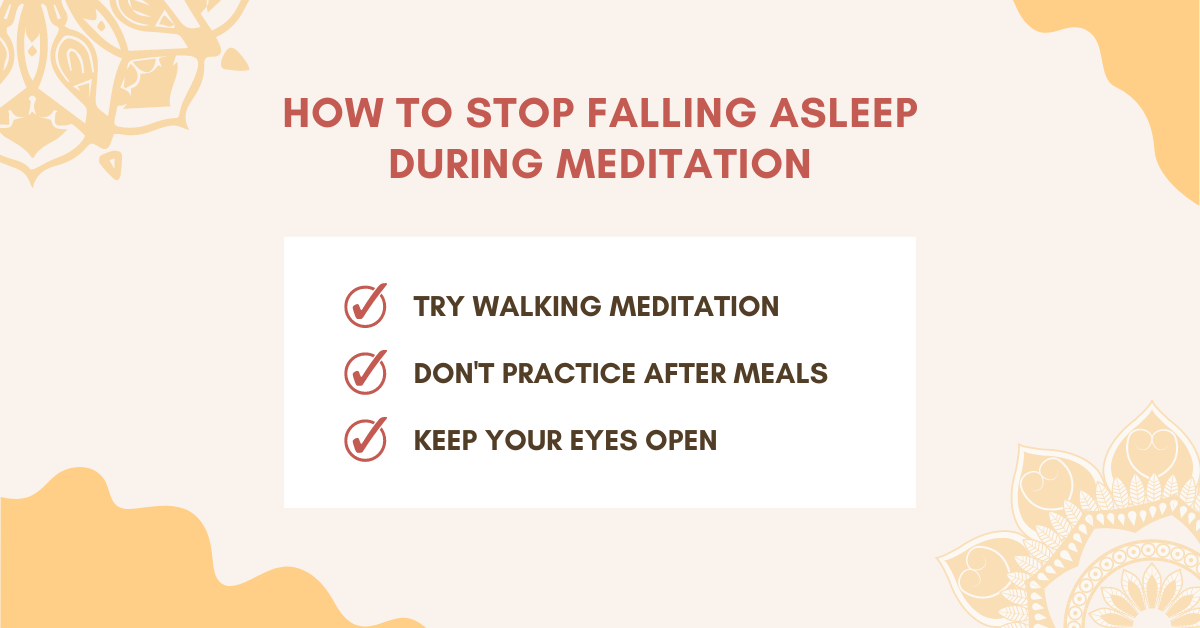
How Do I Know if I’m Meditating the Right Way?
There’s no right or wrong way to meditate, and everyone experiences meditation in their own way. That said, there are some things that many people experience while meditating:
- A heightened sense of awareness – of your surroundings as well as your thoughts and emotions
- You stop making judgments and simply observe
- You become enveloped in a state of stillness
You may notice that you feel calmer, more relaxed, more resilient to stress and overall, more motivated and joyful if your meditation is progressing.
Am I Still Meditating if I Have Thoughts During My Session?
Yes, you can still meditate even if you have thoughts. The goal isn’t to stop having thoughts. The goal is to simply observe and witness thoughts if they arise, and then let them go.
If you’re too focused on keeping your mind blank and trying to force your mind into not thinking, it will be extremely challenging to get into a meditative state.
Once you stop trying to empty your mind, you’ll find that your thoughts naturally disappear after practice and time.
How Do I Quiet My Mind During Meditation?
If you have a busy mind that’s constantly moving from one thought to another, it can be challenging to really get deep into meditation.
One way to address this issue is to bring your focus back to your breath. Whenever you feel your mind wandering or notice that you’re getting lost in thought, bring your attention to your breath.
Simply shifting your attention back to where you want it to be can help sharpen your focus. Over time, you may find that your mind is naturally quieter.
It may also help to repeat a mantra or to say “in” and “out” with each inhale or exhale. Taking this approach can help ensure that you’re in control of your mind rather than letting it wander on its own.
How Do I Deal with Back or Leg Pain While Meditating?
It’s common to experience leg or back pain while meditating, especially if you’re new to the practice and sitting in positions you don’t normally sit in. But pain should never be a part of your practice.
If you’re feeling any kind of back or leg pain while you’re meditating, shift your position. Find a comfortable way to sit – any way will do
You can also try:
- Sitting in a chair or up against a wall to support your back
- Placing a blanket or towel under your knees for support
- Using a meditation cushion
- Ensuring that you’re using good posture when sitting
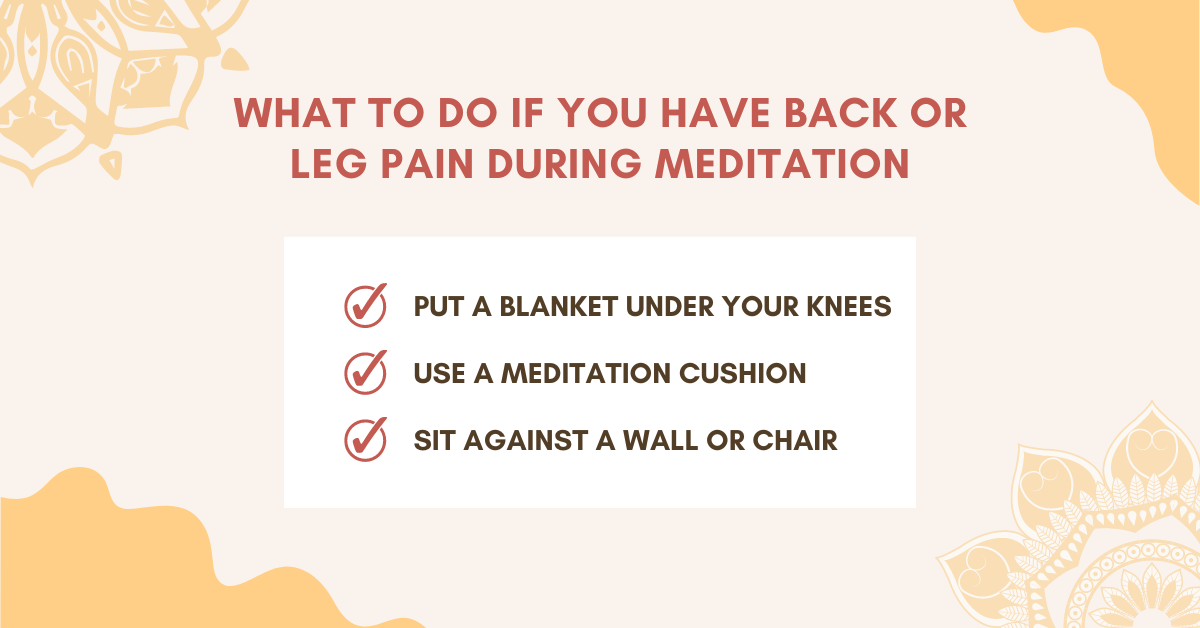
What Should I Wear While Meditating?
You can wear whatever you like while meditating. There are no rules – unless you are attending formal classes or sessions in facilities that have dress codes.
Whatever you wear, make sure you’re comfortable. Clothing that is too tight or constricting can be uncomfortable or even painful and may prevent you from breathing deeply during your practice.
Is There a Specific Way I Should Breathe During Meditation?
There are many breathing exercises out there, and there are many ways to breathe during meditation. But if you’re just getting started, don’t fixate on these things. Just breathe naturally.
It’s okay if you have shallow breathing. It’s okay if you have deep breathing. Just let it be.
Over time, you may find that your breathing patterns change naturally to become slower and deeper.
Final Thoughts
It’s natural to have many questions about meditation, but at the end of the day, it’s a simple practice. Don’t overthink it, and just allow everything just to be.
Rene is a creative, little gnome. When she's not diving deep into research on health and wellness, she's spending here time out in nature, growing her homestead, photographing wildlife, doing yoga or enjoying a zen (depending on the day) moment with her fur babies. And on top of all of that, she's a professional writer by day, helping businesses around the world grow.

